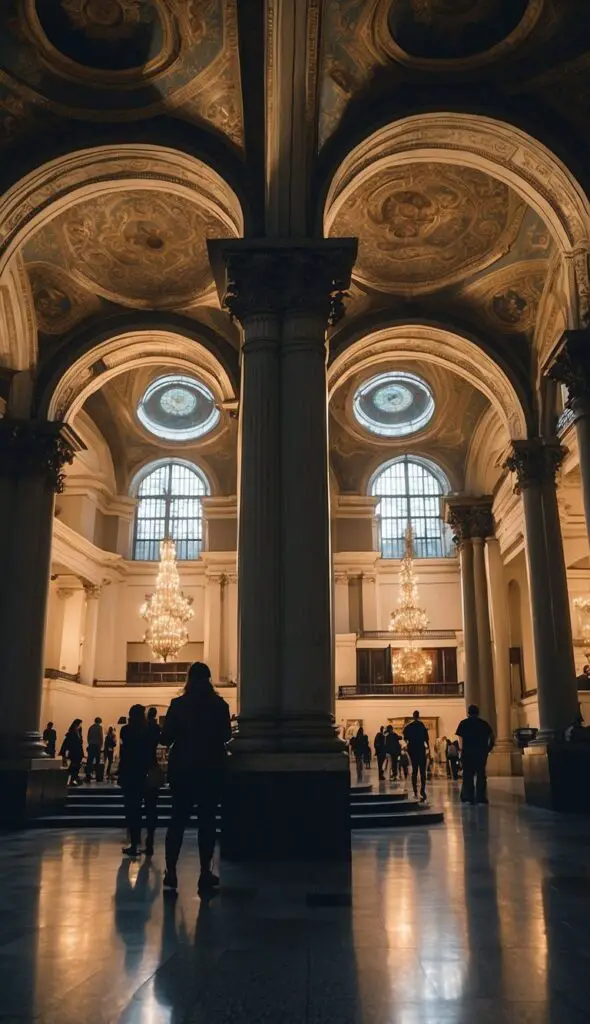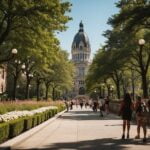Philadelphia stands as a city steeped in history and brimming with cultural repositories that mirror its significance in the American narrative. A tour through the city’s museums is an excursion into a world of art, science, history, and more. Each institution offers a unique narrative, with collections that span the gamut from classical masterpieces to contemporary works, historical artifacts to technological wonders.

The city’s museum landscape is anchored by landmarks like the Philadelphia Museum of Art, with its broad sweep of galleries, and the Barnes Foundation, known for its outstanding collection of impressionist, post-impressionist, and modern works. Alongside these bastions of art, institutions such as the Mütter Museum cater to more niche audiences with its array of medical oddities. Together, these centers of learning and culture form a constellation that not only showcases the magnificence of the artistic endeavor but also fosters an understanding of the diverse threads that weave into the fabric of Philadelphia’s identity.
Engaging with Philadelphia’s museums offers an opportunity not only for visual and intellectual stimulation but also for personal connection to the larger human story. By weaving through the various exhibitions, programs, and tours available, visitors are offered an enriching experience that is both accessible and illuminating, encouraging a deeper appreciation for the collective heritage and contemporary achievements represented in these institutions.
Key Takeaways
- Philadelphia’s museums reflect the city’s rich historical and cultural narrative.
- Key institutions boast significant collections ranging from fine art to scientific curiosities.
- Museum visits offer enriching experiences that connect visitors to a broader human story.
History and Significance of Philadelphia Museums

Philadelphia’s museums are not only repositories of art and history but are also integral to the cultural and educational fabric of the city. From the renowned Philadelphia Museum of Art to the intricate collections at the Mütter Museum, these institutions preserve the rich tapestry of Philadelphia’s heritage and contribute significantly to its status as a center of learning and creativity.
The Founding of Key Institutions
The Philadelphia Museum of Art was chartered in 1876 and is notable for its extensive collection of American, European, and Asian art. Alongside, The Pennsylvania Academy of the Fine Arts, founded in 1805, holds the distinction of being the first art museum and school in the United States. Another transformative institution, The Franklin Institute, established in 1824, honors the legacy of Benjamin Franklin and his contributions to science.
Other significant institutions include The Barnes Foundation, known for its exceptional collection of French Impressionist paintings. The Rodin Museum, which opened in 1929, houses one of the largest collections of Rodin’s works outside France. Furthermore, the Mütter Museum has been displaying medical oddities since the 19th century, and The Penn Museum has been a world leader in archaeology and anthropology since 1887.
- The Academy of Natural Sciences
- The National Constitution Center
- The National Museum of American Jewish History
- The African American Museum in Philadelphia
- The Museum of the American Revolution
Each of these institutions, alongside others, contributes to the storied history and the significant cultural landscape of Philadelphia.
Evolution of Museum Exhibits and Collections
Philadelphia museums continuously expand and adapt their exhibits and collections. The Philadelphia Museum of Art, for example, not only preserves historical artifacts but also embraces contemporary art, reflecting the evolving art scene. Similarly, The Penn Museum has been at the forefront of progressive changes by implementing technology to enhance the visitor experience and engagement with ancient cultures.
The Barnes Foundation maintains its unique approach to display by refusing to rearrange its collection, preserving the founder’s vision. Meanwhile, The Mütter Museum keeps evolving its collection to include modern medical specimens, broadening the visitor’s understanding of medical history and science.
The National Museum of American Jewish History and The African American Museum in Philadelphia emphasize interactive exhibits to narrate their communities’ histories and struggles for equality, making the experience personal and impactful. The Museum of the American Revolution tells the comprehensive story of America’s founding through its immersive exhibitions.
Further, The Academy of Natural Sciences and The National Constitution Center offer engaging experiences, ensuring their exhibits stay relevant and educational.
Philadelphia’s museums play a pivotal role in preserving the past while advancing the public’s appreciation and understanding of art, culture, history, science, and the diversity of human experience.
Major Museums and Their Collections
Philadelphia’s museums house world-renowned collections across various disciplines, from American and Asian art to antiquities and interactive science exhibits.
Philadelphia Museum of Art
The Philadelphia Museum of Art features vast collections that include Renaissance, American, East and South Asian, Impressionist, and contemporary masterpieces. Its expansive offerings make it one of the country’s most significant art institutions.
Barnes Foundation
With an emphasis on Impressionist and Post-Impressionist paintings, the Barnes Foundation boasts an exceptional collection of works by artists like Renoir, Cézanne, Matisse, and Picasso, as well as African sculptures and decorative arts.
The Mütter Museum
The Mütter Museum is distinguished for its collection of medical oddities, anatomical specimens, and historical medical equipment housed within The College of Physicians of Philadelphia.
The Franklin Institute
As a prominent science museum, The Franklin Institute offers a wide array of interactive exhibits promoting science and technology understanding, often featuring innovative engineering and space exploration displays.
Rodin Museum
The Rodin Museum contains one of the largest collections of sculptor Auguste Rodin’s works outside France, highlighting masterpieces like ‘The Thinker’ and ‘The Gates of Hell.’
Museum of the American Revolution
This museum is dedicated to telling the story of the American Revolution through its extensive collection of Revolutionary-era weapons, manuscripts, and personal items.
African American Museum in Philadelphia
Focused on the cultural heritage and history of African Americans, this museum showcases art, artifacts, and textiles that reflect the African American experience in the United States.
Academy of Natural Sciences of Drexel University
The Academy specializes in the natural world, with exhibits that span from dinosaur fossils and dioramas to displays of rare animals from around the globe.
Pennsylvania Academy of the Fine Arts
Known for its American art collections, the Pennsylvania Academy of the Fine Arts houses a mix of historical and contemporary works, giving insight into the evolving culture of American art.
Penn Museum
This museum is renowned for its archaeological and anthropological collections, featuring artifacts from ancient Egypt, Mesopotamia, Asia, and the Mediterranean world.
National Constitution Center
Through multimedia exhibits and historical objects, the National Constitution Center explores the narrative and significance of the U.S. Constitution and its impact on American life.
National Museum of American Jewish History
This institution preserves and interprets the American Jewish experience, with collections ranging from rare books to textiles and cultural artifacts.
The Rosenbach
The Rosenbach is a prominent repository of rare books, manuscripts, and decorative arts, offering a deep dive into literary and historical works, including those of celebrated American author Herman Melville.
Experiencing Museums in Philadelphia

Philadelphia’s museums offer a broad range of visiting options and interactive experiences suited for all ages. Whether an art enthusiast or a family planning a weekend outing, the city’s museums cater to a diverse audience with a variety of interests.
Visiting Options
Most Philadelphia museums are open to the public from Wednesday to Sunday, providing flexible opportunities for visitors to explore cultural and historical exhibits. The Philadelphia Museum of Art, for example, has expansive hours, usually opening mid-morning and closing in the early evening. Each museum sets its own schedule, so checking ahead is advisable.
Admission Information
Admission policies vary across museums, with institutions such as The African American Museum in Philadelphia offering different prices for adults and concessions for students. General admission tickets can often be purchased on-site, but it’s recommended to buy in advance to avoid queues, especially for popular attractions. Some museums also offer free admission on select days, like the Please Touch Museum which may have free entry periods for families to enjoy.
| Day | General Admission | Students |
|---|---|---|
| Wednesday | Yes | Discount |
| Friday | Yes | Discount |
| Saturday | Yes | Discount |
| Sunday | Yes | Discount |
Interactive and Family-Friendly Exhibits
Philadelphia museums excel in offering interactive exhibits designed to engage and educate visitors of all ages. The Please Touch Museum is particularly renowned for its hands-on approach, inviting children to learn through play. Additionally, many museums feature special exhibits on various days like Wednesday or Saturday, where families can participate in activities that make the experience both fun and informative.
Special Exhibitions and Events

Philadelphia’s museums offer a vibrant array of special exhibitions and events, ranging from dynamic temporary exhibits to enriching educational programs and diverse cultural festivals. These venues exemplify the city’s rich cultural heritage and art scene.
Temporary Exhibits
The Philadelphia Museum of Art is renowned for its temporary exhibits, which often highlight both historic and contemporary artists. An exceptional event to look forward to is Mary Cassatt at Work, beginning from May 18 through September 8, 2024, showcasing pieces from the Pennsylvania-born artist who became a key figure in the French Impressionists movement.
Educational Programs
Education is a cornerstone of Philadelphia’s museums, offering numerous programs for learners of all ages. Visitors can immerse themselves in artist talks, interactive tours, and hands-on workshops. Families can also enjoy drop-in art making and specially curated family tours, ensuring that art education is accessible to everyone, including youth.
Cultural Festivals
The city’s museums do not just limit themselves to visual arts; they embrace the wider spectrum of cultural events. From live music evenings to community-driven festivals, these museums serve as a hub for heritage and contemporary culture. Throughout the year, one can experience a multitude of festivals that celebrate the diverse cultures represented in Philadelphia.
Accessibility and Transportation

Philadelphia’s museums offer accessible options for visitors with varying needs while providing a range of transportation avenues through the city’s diverse landscapes.
Accessibility for Diverse Visitors
Philadelphia museums prioritize accessibility, ensuring that all guests experience the rich cultural offerings without barriers. The Philadelphia Museum of Art, for example, is accessible to visitors who use wheelchairs, featuring one of the nation’s largest art collections. Initiatives like ACCESS promote affordability and accessibility across over 80 cultural sites, giving discounted admissions to individuals receiving public assistance.
Navigating Philadelphia’s Transit System
Navigating through Philadelphia’s transit system is vital for museum visits, and the city’s infrastructure facilitates this through multiple means of transportation:
- By Bus: Bus routes crisscrossing the city, including those connecting to the Benjamin Franklin Parkway, make traveling convenient.
- On Foot: Many museums in areas such as Center City and Rittenhouse are within walkable distances, making it easy for pedestrians.
- By Car: For visitors who prefer driving, ample parking is often available near major streets like Broad Street.
Whether one traverses by bus or explores Philadelphia by foot, the transit system supports an efficient journey across the city’s museum landscape.
Surrounding Attractions
The museums of Philadelphia are complemented by rich historical landmarks, vibrant cultural neighborhoods, and refreshing urban green spaces that enhance the city’s charm.
Historic Sites
Independence Hall, the birthplace of the United States, is an unforgettable landmark where both the Declaration of Independence and Constitution were debated and adopted. Nearby, the Liberty Bell, an iconic symbol of American independence, also attracts numerous visitors each year. Another historic site, Eastern State Penitentiary, offers insightful tours of its once formidable structure, including the cell of the infamous gangster Al Capone.
Cultural Neighborhoods
The storied streets of Old City are known for their undeniable historical aura, housing some of the city’s oldest buildings and cobblestone alleys. Moving westward, Rittenhouse and Fairmount are recognized for their cultural landmarks and institutions, while Germantown is lauded for preserving important events in local history within its historic houses. South Philadelphia emerges as a culturally rich area, reflecting the diverse fabric of the city’s heritage through food, markets, and community events.
Urban Green Spaces
Fairmount Park exemplifies Philadelphia’s dedication to urban greenery, offering residents and visitors alike sprawling landscapes to explore and relax in. In the heart of Center City Philadelphia, one finds the majestic City Hall, surrounded by open spaces that serve as urban oases amid the bustling metropolis. These green spaces play a pivotal role in providing serene settings for leisure activities and family-friendly attractions within the urban landscape.
Museum Planning and Visitor Tips

Philadelphia’s museums offer rich experiences with world-renowned art collections and historical exhibits. Effective planning can enhance visits, allowing for a deeper appreciation of cultural treasures and smoother navigation through the city’s diverse institutions.
Best Times to Visit
Visiting museums at the right time can significantly impact the quality of your experience. The Philadelphia Museum of Art suggests taking advantage of Pay What You Wish admission on the first Sunday of the month and every Friday night. Additionally, many museums have less traffic during weekday mornings. For those interested in specific artists like Van Gogh, Picasso, Renoir, Cézanne, or Matisse, checking exhibition schedules and member previews can provide a quieter, more exclusive view.
Maximizing Your Museum Experience
To fully immerse in Philadelphia’s museums, consider purchasing a General Admission Ticket that may include multiple-day entries or discounts to other local museums like the Institute of Contemporary Art. Enthusiasts of contemporary art, including works by Albert C. Barnes and Andy Warhol, may benefit from membership programs offered by institutions, which often come with perks such as special access to exhibitions or events affiliated with the University of Pennsylvania or the College of Physicians.
Exploring Beyond Main Buildings
While the main buildings house a plethora of masterpieces from artists such as Winslow Homer, exploration beyond can yield its rewards. The Philadelphia Museum of Art, for instance, is more than just its central structure; it includes peripheral attractions like the Rodin Museum and historic houses in Fairmount Park that enrich the cultural experience. Take time to explore these less trafficked areas for a more comprehensive understanding of Philadelphia’s art scene.
Community Engagement and Education

Philadelphia museums play a significant role in fostering community relations and educational development. Their efforts are centered around providing inclusive access to arts and culture, enhancing learning for members and students through innovative programs, and utilizing technology to amplify their outreach.
Museum Memberships and Donations
Museum memberships offer patrons a chance to support and engage with the arts. For example, members of the Philadelphia Museum of Art are integral to sustaining initiatives that make the museum a progressive platform where art is accessible to everyone in Philadelphia and beyond. Donations, large or small, fuel programs that reach various community groups, enhancing the museum’s role as a hub for public education and cultural activities.
Volunteer Opportunities
Volunteer opportunities cater to individuals eager to contribute their time to the art community. Museums such as the Pennsylvania Academy of the Fine Arts (PAFA) rely on volunteers to support their school and community partnerships, offering educational art workshops in collaboration with local entities such as the Free Library of Philadelphia. This collaboration provides valuable out-of-school settings where students and families can engage with art in a hands-on environment.
Educational Outreach
The engagement extends to the educational sphere through structured outreach programs. These are designed to supplement school curriculums and provide diverse learning experiences. For instance, programs orchestrated by The Philadelphia Office of Arts, Culture, and the Creative Economy involve preservation of historic objects and their stories, like those of the Christopher Columbus statue, enriching history and social studies lessons. Integration of technology in education is another key facet, with digital resources and online workshops making art education more accessible to students unable to visit in person.
Conservation and Research
In Philadelphia, museums are not only custodians of art and history but also play a pivotal role in the conservation of collections and the advancement of scientific research. They are dedicated to preserving cultural artifacts and furthering knowledge across various disciplines, including art, science, and natural history.
Preservation of Art and Artifacts
At the Philadelphia Museum of Art, conservators undertake meticulous work to maintain art objects, ensuring their longevity for future generations. This includes the analysis and treatment of works from vast collections spanning the globe. Similarly, the Conservation Center for Art & Historic Artifacts specializes in the preservation of paper-based materials, rare books, and photographs, supporting collections both within Philadelphia and nationwide.
Scientific Research and Discoveries
The Academy of Natural Sciences of Philadelphia is renowned for its scientific research, particularly in the realm of natural history. It boasts a rich collection of specimens that provide invaluable insight into biodiversity and environmental science. Researchers here contribute significantly to new discoveries that deepen our understanding of the natural world.
Public Archives and Libraries
Philadelphia’s public archives and libraries, such as the Historical Society of Pennsylvania, maintain extensive collections of manuscripts and archival materials. They are integral resources for academic research and public education, making Philadelphia a hub for historical study and preservation.
Each institution in Philadelphia contributes to the conservation and research of art, artifacts, and rare materials, solidifying the city’s status as a center for cultural enrichment and scientific inquiry.
Frequently Asked Questions
When planning a visit to Philadelphia’s museums, visitors commonly inquire about the top attractions, ticket purchasing options, free admissions, and recommendations for adult visitors. This section provides clear, concise answers to these inquiries.
What are the top-rated museums to visit in Philadelphia?
The city boasts many celebrated institutions, but the Museum of the American Revolution and the Philadelphia Museum of Art are amongst the top-rated museums to visit due to their rich historical collections and wide range of exhibits.
Where can I find information about purchasing tickets for the Philadelphia Museum of Art?
For current ticket options and pricing, visitors should visit the official Philadelphia Museum of Art website, which provides detailed information about various ticket types, including those for special exhibitions.
Which museums in Philadelphia offer free admission?
Several museums in Philadelphia offer free admission, but it is essential to check each museum’s website or contact them directly for the most up-to-date information on complimentary access opportunities.
Can you recommend some museums suitable for adults in Philadelphia?
Adult visitors seeking an enriching cultural experience may explore the Philadelphia Museum of Art for its diverse European and American collections or the African American Museum in Philadelphia for a profound look into African-American heritage.
How many museums are located in Philadelphia, and which is the largest?
Philadelphia is home to numerous museums, though exact numbers can vary with new openings and closures. The Philadelphia Museum of Art is often considered the largest based on its extensive collections and exhibition space.
Are there any notable African American museums to visit in the city of Philadelphia?
The African American Museum in Philadelphia (AAMP) is a notable institution dedicated to preserving African-American heritage with over 750,000 artifacts, making it a poignant and significant destination within the city.





